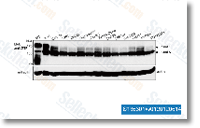It had been des ignated SYPHC medium and has the following com place. 35. 00 g sea salts, 0. 10 g NH4Cl, 0. 05 g KH2PO4, 2. 50 g HEPES one piperazineethanesulfonic acid 1. 00 g yeast extract, 1. ten g sodium pyruvate, 0. 04 g L histidine, 0. 04 g L cysteine HCl ? H2O, 1. 00 ml Wolfes mineral elixir, and one. 00 ml nutritional vitamins option, All components had been dissolved in water ex cept NH4Cl and KH2PO4, which were added soon after autoclaving from a sterile stock alternative. The pH of the medium was adjusted to seven. five seven. 7 before car claving. For incubation of cultures in closed serum vials below defined gasoline atmospheres the SYPHC medium was slightly modified. All compounds, ex cept the HEPES buffer which was omitted, have been dissolved in water after which the choice was sparged by using a 80% N2 and 20% CO2 fuel mixture for 45 min to take out dissolved oxygen.
Diverse concentrations of oxygen in the headspace learn this here now gasoline ambiance have been obtained by filling serum vials with anoxic medium to sure levels as described previously, The pH on the medium was adjusted to 7. three 7. five immediately after autoclav ing by adding Na2CO3 from a sterile and anoxic stock remedy that was prepared beneath a 80% N2 and 20% CO2 gasoline environment. In some experiments the sodium pyruvate in SYPHC medium was replaced with sodium DL malate along with the resulting medium was desig nated SYMHC or SYM, if your amino acids L histidine and L cysteine IEM-1754 had been omitted. All chemical substances have been obtained from Sigma Aldrich and complicated nutrients from DIFCO BBL, Determination of development and phenotypic traits The absorbance values of developing cultures have been deter mined within a Thermo Scientific BioMate six split beam UV noticeable spectrophotometer implementing one cm light path dispos able cuvettes and water as blank.
The A660nm reading was made use of to estimate the cell density. Expression on the light harvesting complicated in strain Ivo14T was estimated by identifying the A870nm to A660nm ratio, whereas for cultures of C. litoralis and Chromatocurvus halotolerans a ratio of A880nm to A660nm was utilised and for H. rubra a ratio of A820nm to A660nm. The cellular dry fat of  grown cultures was determined by overnight freeze drying of cell pellets harvested by centrifugation. A com parison with the established cellular dry weights with cor responding absorbance values exposed equivalent ratios for that strains Ivo14T, Chromatocurvus halotolerans DSM 23344T and H. rubra DSM 19751T grown in defined medium with pyruvate as carbon source at 660 nm, respectively. Considerably increased ratios were obtained on cultivation of these strains in complicated media containing malate and yeast extract, which may perhaps be resulting from the storage of reserve polymers. The corresponding values for strains Ivo14T, DSM 23344T and DSM 19751T had been 0.
grown cultures was determined by overnight freeze drying of cell pellets harvested by centrifugation. A com parison with the established cellular dry weights with cor responding absorbance values exposed equivalent ratios for that strains Ivo14T, Chromatocurvus halotolerans DSM 23344T and H. rubra DSM 19751T grown in defined medium with pyruvate as carbon source at 660 nm, respectively. Considerably increased ratios were obtained on cultivation of these strains in complicated media containing malate and yeast extract, which may perhaps be resulting from the storage of reserve polymers. The corresponding values for strains Ivo14T, DSM 23344T and DSM 19751T had been 0.
Peptides Price
A gene coding for a selectable marker such as antibiotic resistance is also incorporated into the vector.
